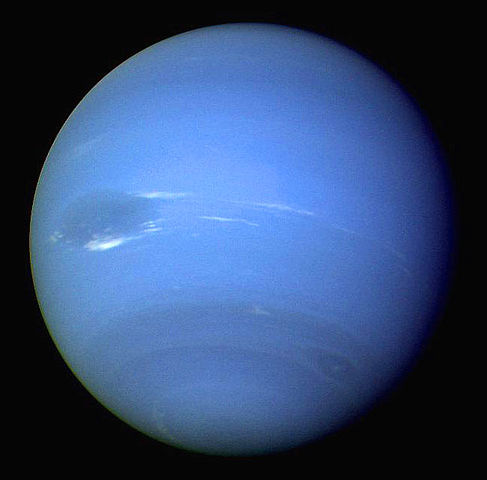 |
This is a file from the Wikimedia Commons. Information from its description page there is shown below.
Commons is a freely licensed media file repository. You can help.
|
| Description |
Neptune English:
Original Caption Released with Image: During August 16 and 17, 1989, the Voyager 2 narrow-angle camera was used to photograph Neptune almost continuously, recording approximately two and one-half rotations of the planet. These images represent the most complete set of full disk Neptune images that the spacecraft will acquire. This picture from the sequence shows two of the four cloud features which have been tracked by the Voyager cameras during the past two months. The large dark oval near the western limb (the left edge) is at a latitude of 22 degrees south and circuits Neptune every 18.3 hours. The bright clouds immediately to the south and east of this oval are seen to substantially change their appearances in periods as short as four hours. The second dark spot, at 54 degrees south latitude near the terminator (lower right edge), circuits Neptune every 16.1 hours. This image has been processed to enhance the visibility of small features, at some sacrifice of colour fidelity. The Voyager Mission is conducted by JPL for NASA's Office of Space Science and Applications.
Português:
Título original Liberado com imagem: Durante 16 e 17 de Agosto, 1989, o Voyager 2 a câmera de estreito-ângulo foi usada para fotografar Netuno quase continuamente, gravação aproximadamente duas e meia rotações do planeta. Estas imagens representam o mais completo grupo de imagens do disco cheio de Netuno que a nave espacial adquirirá. Este retrato da seqüência mostra duas das quatro características da nuvem quais foram seguidos pelas câmeras de Voyager durante os dois meses passados. O oval escuro grande perto do limbo ocidental (a borda esquerda) está em uma latitude de 22 graus ao sul e circuita Netuno cada 18,3 horas. As nuvens brilhantes imediatamente ao sul e leste deste oval são vistas para mudar substancialmente suas aparências nos períodos tão curtos como quatro horas. O segundo ponto escuro, a 54 graus de latitude sul perto do terminal (borda direita maissey baixa), circuita Netuno cada 16,1 horas. Esta imagem foi processada para realçar a visibilidade de características pequenas, em algum sacrifício da fidelidade da cor. A missão de Voyager é conduzida por JPL para o escritório da NASA da ciência e das aplicações do espaço.
Deutsch: Der Planet Neptun, aufgenommen von der Raumsonde Voyager 2 im August 1989
|
| Date |
August 1989 |
| Source |
http://photojournal.jpl.nasa.gov/catalog/PIA00046 |
| Author |
. |
Permission
( Reusing this file) |
| Public domainPublic domainfalsefalse |
 |
This file is in the public domain because it was solely created by NASA. NASA copyright policy states that "NASA material is not protected by copyright unless noted". (See Template:PD-USGov, NASA copyright policy page or JPL Image Use Policy.) |
|
|
|
Warnings:
- Use of NASA logos, insignia and emblems are restricted per US law 14 CFR 1221.
- The NASA website hosts a large number of images from the Soviet/ Russian space agency, and other non-American space agencies. These are not necessarily in the public domain.
- Materials based on Hubble Space Telescope data may be copyrighted if they are not explicitly produced by the STScI. See also {{ PD-Hubble}} and {{ Cc-Hubble}}.
- The SOHO (ESA & NASA) joint project implies that all materials created by its probe are copyrighted and require permission for commercial non-educational use.
- Images featured on the Astronomy Picture of the Day (APOD) web site may be copyrighted.
|
|
| Annotations |
This image is annotated: View the annotations at Commons |
|
|
File usage
The following pages on Schools Wikipedia link to this image (list may be incomplete):
This file contains additional information, probably added from the digital camera or scanner used to create or digitize it. If the file has been modified from its original state, some details may not fully reflect the modified file.
Wikipedia for Schools is one of SOS Children's many educational projects. SOS Children's Villages believes education is an important part of a child's life. That's why we ensure they receive nursery care as well as high-quality primary and secondary education. When they leave school, we support the children in our care as they progress to vocational training or higher education. We have helped children in Africa for many years - you can help too...





